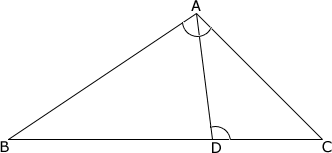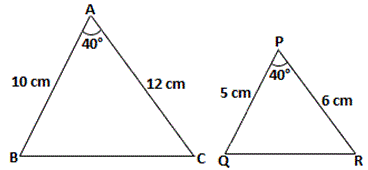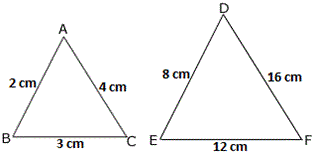Solved Examples and Worksheet for Similar Figures
A. 13.5 cm
B. 32 cm
C. 12 cm
D. 9 cm
Step: 1

Step: 2
[Given.]
Step: 3
Step: 4
ΔABC ~ ΔDAC
[AA similarity postulate.]
Step: 5
[ΔABC is similar to ΔDAC.]
Step: 6
[Substitute.]
Step: 7
CD = 324 24
[Cross product property.]
Step: 8
CD = 13.5 cm
[Simplify.]
Correct Answer is : 13.5 cm

A. 4 cm
B. 3 cm
C. 3 cm
D. 2 cm
Step: 1
Let BC = x
Step: 2
DC = DB - BC = (5 - x
Step: 3
[Vertically opposite angles are congruent.]
Step: 4
[Alternate angles are congruent]
Step: 5
ΔACB ~ ΔECD
[AA similarity postulate.]
Step: 6
[Corresponding sides of similar triangles are proportional]
Step: 7
Step: 8
6x x
[Cross multiply.]
Step: 9
6x x
[Multiply.]
Step: 10
10x
[Combine like terms.]
Step: 11
[Divide by 10 on both sides.]
Step: 12
[Simplify.]
Step: 13
BC = 2 cm
Correct Answer is : 2 cm
A. 12 in.
B.
C.
D. 10 in.
Step: 1
ΔPQR and ΔABC are similar so that the corresponding sides are proportional. Thus, we can write proportions to find the measure of AC ¯
Step: 2
[Write a proportion.]
Step: 3
[Substitute the values.]
Step: 4
3AC = 40
[Cross products.]
Step: 5
AC = 13 1 3
[Solve.]
Correct Answer is : 13 1 3

A. 50 units
B. 10 units
C. 8 units
D. 11 units
Step: 1
If two polygons are similar, then the corresponding sides are in proportion.
Step: 2
[CD corresponds to GH and AB corresponds to EF.]
Step: 3
[Substitute the values.]
Step: 4
30 × n
[Write the cross products.]
Step: 5
30n
[Multiply.]
Step: 6
[Divide both sides by 30.]
Step: 7
The value of n
Correct Answer is : 8 units
I. The corresponding angles of similar polygons are always congruent.
II. Two similar polygons are always congruent.
III. The corresponding sides of similar polygons are always congruent.
A. I and II only
B. II only
C. II and III only
D. III only
Step: 1
The corresponding angles of similar polygons are congruent.
[By definition.]
Step: 2
Two congruent figures are always similar but two similar polygons need not be congruent.
[By definition.]
Step: 3
The corresponding sides of similar polygons are proportional but need not be congruent.
[By definition.]
Step: 4
So, statements II and III are incorrect.
Correct Answer is : II and III only
I. All parallelograms are not similar.
II. All equilateral triangles are similar.
III. All isosceles triangles are similar.
IV. All congruent triangles are similar.
A. I only
B. II and IV only
C. III and IV only
D. III only
Step: 1
Amongst the choices, the statement "all isosceles triangles are similar" is the incorrect statement.
Correct Answer is : III only
I. Corresponding angles are congruent.
II. Corresponding sides are proportional.
III. Corresponding sides are congruent.
A. I and II only
B. II and III only
C. III only
D. I only
Step: 1
The corresponding angles of similar polygons are congruent.
[By definition.]
Step: 2
For similar triangles, corresponding sides are proportional but need not be congruent.
[By definition.]
Step: 3
So, statement III is incorrect.
Correct Answer is : III only

A. SSS similarity theorem
B. AA similarity
C. SSA similarity theorem
D. SAS similarity theorem
Step: 1
From the figure, we have ∠ A ≅ ∠P = 40°
Step: 2
Step: 3
Step: 4
⇒ A B P Q A C P R
Step: 5
SAS similarity theorem states that two triangles are similar if two sides in one triangle are in the same proportion to the corresponding sides in the other, and the included angles are equal.
Step: 6
Therefore, ΔABC ∼ ΔPQR by SAS similarity theorem.
Correct Answer is : SAS similarity theorem

A. AA similarity
B. SSS similarity theorem
C. SSA similarity theorem
D. SAS similarity theorem
Step: 1
From the figure, we have A B D E 2 8 1 4
Step: 2
Step: 3
Step: 4
⇒ A B D E B C E F A C D F
Step: 5
SSS similarity theorem states that if the corresponding sides of two triangles are proportional, then the triangles are similar.
Step: 6
Therefore, ΔABC ∼ ΔDEF by SSS similarity theorem.
Correct Answer is : SSS similarity theorem
I.
II. ∠A = ∠B = ∠C = ∠P = ∠Q = ∠R
III.
IV. ∠A = ∠P, ∠B = ∠Q, ∠C = ∠R.
A. I and IV only
B. II and III only
C. I only
D. III and IV only
Step: 1
Two triangles are similar if and only if their corresponding angles are congruent and the measures of their corresponding sides are proportional.
[By definition.]
Step: 2
ΔABC is similar to ΔPQR.
[Given.]
Step: 3
Therefore, A B P Q B C Q R A C P R
Correct Answer is : I and IV only
- Congruent Triangles-Geometry-Solved Examples
- Centre and Scale Factor in Dilation-Geometry-Solved Examples
- Application of the Pythagorean Theorem-Geometry-Solved Examples
- Special Right Triangles-Geometry-Solved Examples
- Trigonometric Ratios-Geometry-Solved Examples
- Application Problems involving Trigonometric Functions-Geometry-Solved Examples
- Law of Sines and Cosines to Solve Triangles-Geometry-Solved Examples
- Areas of Triangles using Trigonometry-Geometry-Solved Examples
Related Worksheet
- Similar Figures